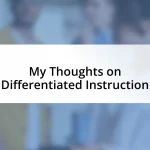Key takeaways:
- Cooperative learning enhances teamwork, critical thinking, and problem-solving through peer interactions.
- Key principles include positive interdependence, individual accountability, and social skills development, fostering a sense of community.
- Effective group dynamics strategies involve assigning clear roles, building trust, and resolving conflicts respectfully.
- Engaging activities spark curiosity and connect learning to real-world scenarios, making education more memorable and impactful.

Understanding Cooperative Learning Benefits
Cooperative learning transforms the classroom into a dynamic environment where students not only share knowledge but also build essential social skills. I remember a group project where I initially felt overwhelmed, but as we collaborated, I discovered the power of exchanging ideas. It struck me how much more we can achieve together—doesn’t it just feel empowering to know teamwork can elevate our learning experience?
One of the most significant benefits is the opportunity for peer learning. When I struggled with a challenging concept, a classmate explained it in a way that suddenly made everything clear. This shared understanding fosters a sense of community and belonging—who doesn’t want to feel connected and supported in their educational journey?
Additionally, cooperative learning cultivates critical thinking and problem-solving skills. Working in groups puts us in real-world scenarios where we must negotiate, consider different perspectives, and arrive at shared solutions. Have you ever thought about how much we grow when challenged to articulate our ideas and listen to others? It’s this back-and-forth dialogue that sharpens our thinking and equips us for future endeavors.

Key Principles of Cooperative Learning
Cooperative learning thrives on certain key principles that guide its effectiveness. One principle that stands out to me is individual accountability. In my experience, when each member of a group understands their responsibilities, it creates a sense of ownership that drives engagement. I remember a time when my contribution was directly tied to our group’s success, and it motivated me to dig deeper, to bring my best to the table.
Here are some essential principles of cooperative learning:
- Positive Interdependence: Each student’s success is linked to the group’s success, fostering teamwork.
- Face-to-Face Interaction: Engaging directly with peers encourages discussion and helps clarify concepts.
- Individual Accountability: Ensuring that each member contributes and understands the material enhances group efficacy.
- Group Processing: Reflecting on what works well and what can improve in the group dynamic leads to better collaboration in future projects.
- Social Skills Development: Cooperative learning hones skills like communication, conflict resolution, and leadership, all vital in real-world situations.
Furthermore, I find that diversity within groups also enhances learning outcomes. During one memorable project, our team was a mix of backgrounds and perspectives. This mosaic of ideas led to richer discussions and creative solutions. I often think about how embracing our differences generated excitement and innovation—it taught me the invaluable lesson that every voice matters in the learning process.

Effective Group Dynamics Strategies
When it comes to fostering effective group dynamics, establishing clear roles can make all the difference. I recall a project in college where we assigned specific responsibilities based on each person’s strengths. This not only helped everyone feel valued, but it also streamlined our collaboration. It’s fascinating how clarity can transform chaos into a cohesive effort—have you noticed how much smoother things go when everyone knows their part?
Building trust within the group is another vital strategy. During a particularly challenging assignment, our group took a few minutes to share personal stories and experiences. This exercise surprisingly deepened our connection and opened the lines of communication. I believe that when we share our vulnerabilities, it humanizes us and allows for more honest dialogue—do you find that openness enhances collaboration?
Lastly, effective conflict resolution processes are essential for maintaining group harmony. In one project, we faced disagreement on our approach. Instead of letting it fester, we took time to listen to each other’s viewpoints, leading to a more informed decision. I’ve learned that respectful discussions about differences can lead to innovation—what’s your experience with conflict in group settings? It seems that navigating these moments well can be a stepping stone to stronger collaboration.
| Strategy | Benefits |
|---|---|
| Assign Clear Roles | Enhances accountability and focuses efforts. |
| Build Trust | Fosters open communication and strengthens connections. |
| Conflict Resolution | Turns disagreements into pathways for innovation. |

Designing Engaging Group Activities
Designing engaging group activities often starts with sparking curiosity. I remember organizing a scavenger hunt for a class project that had everyone searching for clues related to our subject matter. The excitement in the room was palpable; it transformed learning from a task into an adventure. Have you noticed that when learning feels like play, it’s more memorable?
In my experience, incorporating creative elements can really energize a group. For instance, I once asked classmates to role-play different stakeholders in a historical event. Each person immersed themselves fully in their character, and the lively discussions that ensued were both enlightening and entertaining. It’s astounding how creativity can unlock deeper understanding—don’t you feel more engaged when the activity resonates with your interests?
Another strategy I’ve found effective is to connect activities to real-life scenarios. I once led a brainstorming session where we tackled community issues. The strong opinions and collaborative spirit that emerged were invigorating. I realized that when students see the relevance of their work, they invest more heart and effort. Have you ever experienced a project where the real-world connection made you feel more passionate? Those moments truly highlight the power of engaging group activities.

Assessing Group Work Effectively
Assessing group work effectively hinges on using a variety of evaluation methods. I remember a course where our instructor gathered feedback from each group member about their peers’ contributions, which offered an honest perspective on individual efforts. It was eye-opening to see how we often have different perceptions of participation—have you noticed that the person who speaks the most isn’t always the one doing the most work?
Rubrics are another tool I find invaluable for assessment. During one particularly complex project, we used a detailed rubric that outlined expectations for both the final product and individual contributions. This clarity not only kept us on track but also provided a concrete way to gauge our performance. I believe this structure helped reduce ambiguity—wouldn’t you agree that knowing what is expected makes it easier to meet those expectations?
Lastly, self-assessments can serve as a powerful reflection tool. I once participated in a group where we rated our own involvement and discussed our reflections as a team. This candid exploration prompted some members to realize areas for growth they hadn’t previously considered. It’s fascinating how looking inward can lead to collective improvement—don’t you think self-awareness can amplify the effectiveness of a group’s dynamics?

Fostering Positive Interdependence
Fostering positive interdependence is essential for successful cooperative learning. I recall being part of a team tasked with building a model for a science project. Each member had a specific role, and relying on one another created this incredible synergy. It was rewarding to see how our different skills combined to produce something greater than any of us could achieve individually. Can you think of a time when collaboration brought out your best efforts?
Creating opportunities for shared goals also enhances positive interdependence. During a group project in college, we defined a common objective that resonated with all of us. It wasn’t just about completing the assignment; we genuinely wanted to excel. That collective desire transformed our interactions—I felt more responsible for my teammates’ success than my own. Have you ever felt that deep connection where the group’s achievement felt like a reflection of your own dedication?
Additionally, recognizing individual contributions can bolster this sense of interdependence. I remember an experience where, after our project, we took turns highlighting what each person brought to the table. This practice not only boosted morale but also reinforced the idea that our success hinged on every member’s efforts. It’s fascinating how acknowledgment can build trust—don’t you think we thrive when our contributions are seen and appreciated?

Overcoming Challenges in Group Learning
Overcoming challenges in group learning often starts with addressing conflicts head-on. I remember one instance where our group was divided over the direction of a project. It felt incredibly tense. But instead of avoiding the discussion, we decided to have an open meeting where everyone could express their concerns and ideas. What surprised me was how freeing it felt to air out our issues. Have you ever faced a disagreement that turned out to be a catalyst for better teamwork?
Communication barriers can also hinder group dynamics, but they’re solvable if you’re willing to put in the effort. I once worked with a diverse group where language differences led to misunderstandings. To bridge these gaps, we agreed on a set of clear, straightforward communication rules. Implementing these guidelines not only clarified our discussions but also made everyone feel more included. Isn’t it amazing how little adjustments can make a significant impact on group cohesion?
Lastly, time management can be a formidable challenge in group projects. I recall being part of a team that struggled to meet deadlines because we didn’t prioritize tasks properly. To tackle this, we created a shared timeline with specific milestones. Each member took ownership of their responsibilities, and we held weekly check-ins to stay accountable. It felt empowering to see our progress together. Doesn’t it create a sense of accomplishment when everyone pulls together to meet a common deadline?














